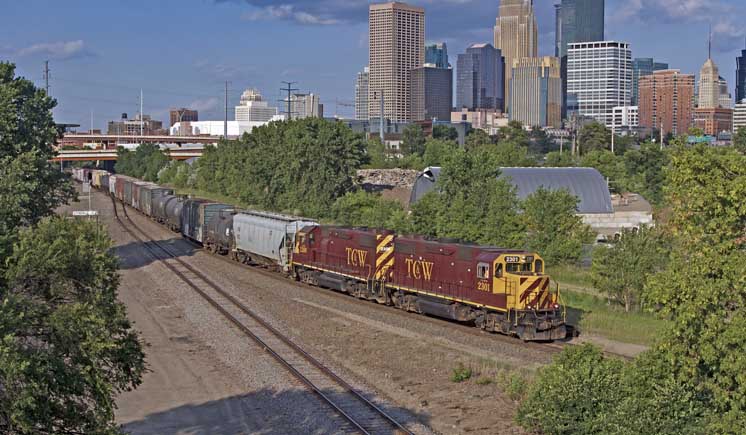
Twin Cities and Western Railroad Company summary
The Twin Cities and Western Railroad Company (TCWR) is a short line railroad that operates in Minnesota and South Dakota. It’s owned by the Minnesota-based Oakes Development Corporation, which also owns the Red River Valley & Western Railroad Company.
Headquartered out of Glencoe, Minn., the railroad operates over 229 miles of former Milwaukee Road standard-gauge track from Minneapolis/St. Paul to Milbank, S.D. The 94-mile Minnesota Prairie Line (MPL) from Norwood Young America to Hanley Falls, Minn., and the 37-mile Sisseton Milbank Railroad Company (SMRC) from Milbank to Sisseton, S.D., serves as subsidiaries to the TCWR. Over 360 miles of track gives the Twin Cities & Western the title as the largest short line in Minnesota.
History
The Twin Cities and Western Railroad was once part of the Milwaukee Road’s main line to the Pacific Northwest in Seattle and Tacoma, Washington. Bankruptcy in 1977 led to an embargo with its tracks to the west coast being sold off in sections. By the time the Soo Line purchased the Milwaukee Road in 1985, remains of the active line from Minneapolis only reached to Ortonville, Minn. What was then known as the “Ortonville Line,” it soon became a candidate for divestiture shortly after the Canadian Pacific Railway took full ownership of the Soo in 1990.
Oaks Development became the successful bidder and on July 27, 1991, operations on the line resumed as the Twin Cities & Western Railroad. Since the early 2000s, the railroad experienced significant expansion to the network. The Minnesota Prairie Line began operations in October 2002 as a subsidiary to the TCWR with rail service restored after it sat dormant for two years. In July 2012, the Sisseton Milbank Railroad Company was acquired by the Twin Cities and Western.
Operations
Traffic on the Twin Cities & Western Railroad has a focus on the agriculture business while hauling corn, soybeans, wheat, sugar, ethanol, crushed rock, metals, plastics, fuel oil, machinery, lumber, manufactured goods, and fertilizer. These commodities from the Minnesota and South Dakota farms and manufacturers are then shipped to markets in 39 U.S. states, Canada, and Mexico. Southern Minnesota Sugar Beet Cooperative at Renville and the Granite Falls Energy’s ethanol plant are the TCWR’s largest customers, with on-line grain elevators generating good business for the railroad. The Minnesota Prairie Line rehabilitated the east end of its railroad to serve the Heartland Corn Products ethanol plant at Winthrop, providing more business by the way of expansion.
EMD GP38-2 diesel locomotives in the maroon-and-gold livery are a common sight on the Twin Cities and Western. The variety of units owned by the railroad ranges in addition from GP39-2s to GP20Cs as they haul freight west of Minneapolis-St. Paul through the prairies of Minn., and S.D.
Service in Minneapolis and St. Paul has granted the railroad interchange with multiple Class I railroads. They include the BNSF Railway, Union Pacific, Canadian Pacific Railway, and Canadian National Railway. The TCWR also has trackage rights over BNSF from Appleton, Minn., to Milbank to reach the Sisseton Milbank Railroad.
Read more about the Twin Cities and Western Railroad Company in Trains’ August 2021 issue.









